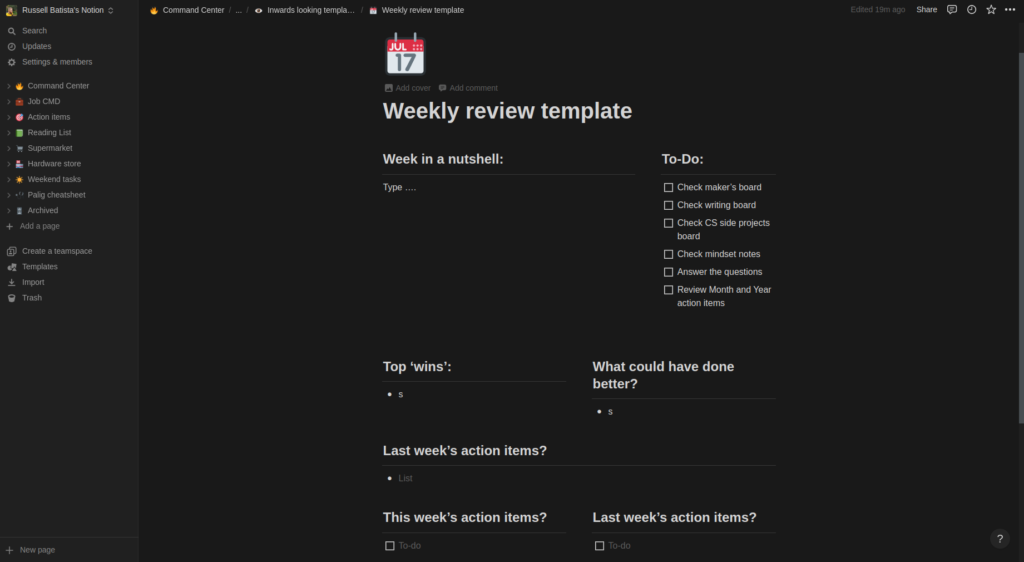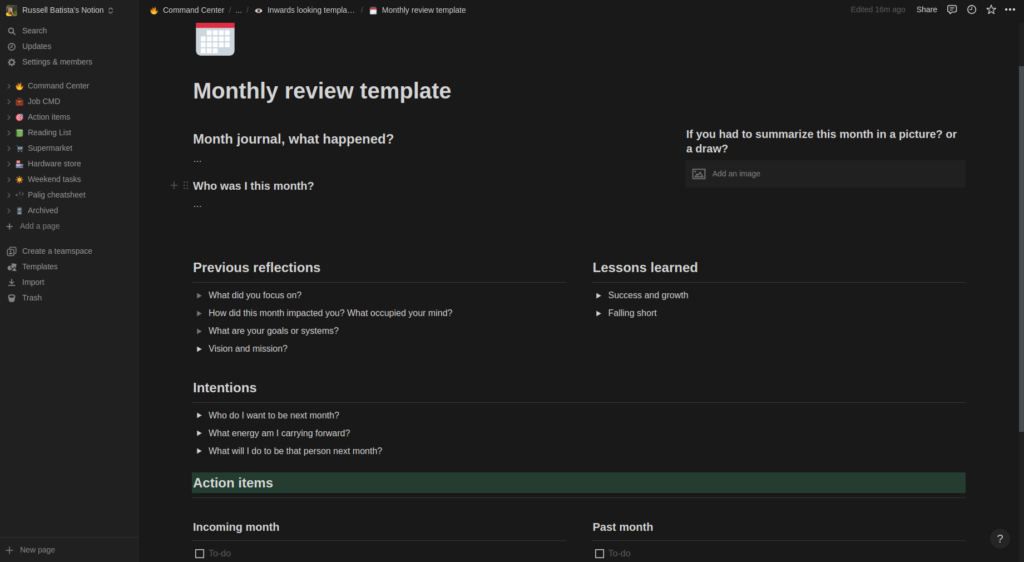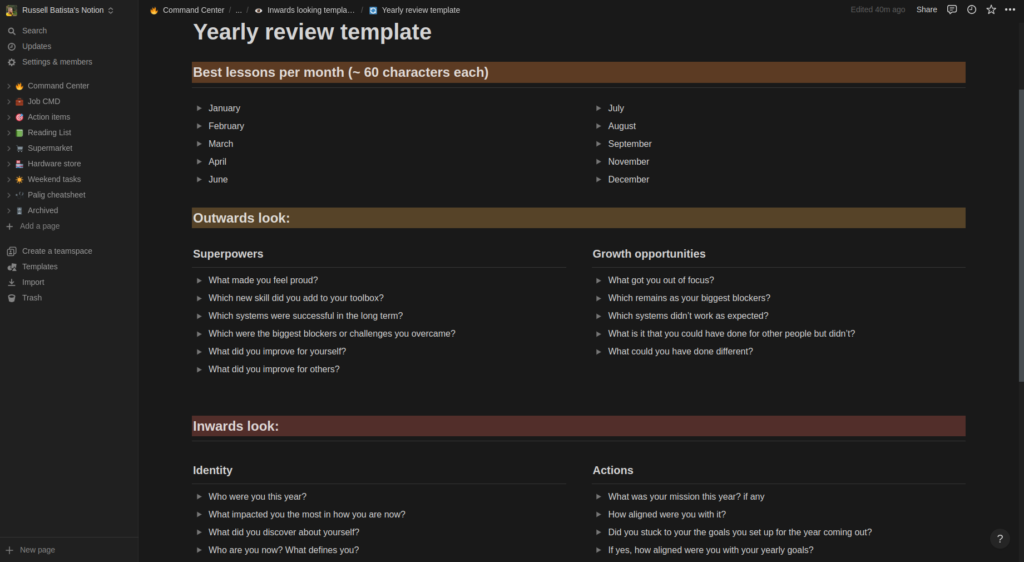Wisdom doesn’t come from experience. It comes from reflecting on experience … Gaining insight and perspective is not about the number of years you’ve lived. It’s about the lessons you’ve learned
Adam Grant
As 2023 is around the corner is time for me to make the final task in one of my top systems that help me level up my work, get things done, decrease anxiety and gain vision. I hope this tool could provide some benefit to you as well.
We perform in environments where urgent launches get delayed at every sunrise. Team metrics are critical for next period’s budget. Theses work grows unfairly every week. And the fact that we have a huge flux of information from multiple sources competing for our attention every minute doesn’t help.
The ability to determine the best next task and being able to focus on it are critical skills, specially when complexity and uncertainty are high. Failing to do so makes many of us struggle with frustration, stress and anxiety on a regular basis.
This struggle goes beyond a lower emotional state. People fail to see the adjustments necessary to move forward until a task or a negative mood remain for too long, or there’s a ill brute force approach, or simply giving up.
Given this issue there’s a complementary, and negative, follow up. People by give up health, relations, leisure time or personal projects in order to work over time.

Normally there isn’t a single root cause, but many. As well as there are many tools to work around this, as the second brain, meditation, pomodoros with timeblocking, dopamine detox, etc. All of these are good, competent tools that, within each person’s individuality, can be useful.
In this post I will emphasize on what for me is a start-with tool. Feedback loops (or Periodic reviews). They are my most powerful system to remove the brain fog and see the big picture.
Feedback loops, why use it as entry tool?
Feedback loops do to your awareness what your eyes do to your painting. If, as a painter, you were asked to paint a human face in a dark room maybe you could expect it to look like a face, but when turning the lights on you may find you made copy of Elias Garcia’s Ecce Homo after being restored by an old lady in 2012.

When painting you see the whole canvas, the colors, the textures, the movements you are doing, you see what’s wrong or right or when you need to change your brush. Any task with immediate feedback won’t turn into Ecce Homo unless your a beginner, which improves over time. However it gets harder if you’re working on long-term processes relying on many parts, which may or not be tangible.
Feedback loops provide awareness. Awareness provides direction. Direction provides actions.
The key to get the most out of a feedback loop is to ask yourself the right questions, which is a skill that grows over time and practice.
How do I make my feedback loop system?
As I put it before, the key lies in the right questions. Make a basic, but functional questionnaire for yourself, even one question could do well for your first iteration. A good single question could drive yo to the right analysis you need.
A quick example of a single question I used to do as SDE is that after completing a task I asked myself:
If this task was getting a car to the top of a hill. Did I push the car Sisyphus-style? or did I drove it?
Answering this question made me want to know why I gave my answer and extract more valuable information for next time. II like it because this single questions are trigger for a chain of why’s. If in a given time, a well-formed question is hard as hell and forces you out of your comfort zone, that’s a question worth answering.
Your first feedback system should be so easy that you can’t say no to it. As you gain experience on this system you’ll find which questions to add or remove to get valuable information.
In a feedback loop oriented to deliver results you may wish to find out three key elements:
- Where am I really heading to with my current actions?
- Where should I go from here?
- Which path is best for me to get there?
There are other feedback loops other than oriented to deliver a value with other questions to ask yourself.
Let me show you my personal examples.
SDE daily review:
These questions help me stayed focus every day, sometimes weekly instead, See Notion template here:
- What is your priority this sprint?
- …
- What’s your long/mid term goal?
- …
- What are you going to put your grain of sand to it?
- …
- What are you going to do today? (this is cheat sheet for standup)
- …
- What you did yesterday? (this is cheat sheet for standup)
- …
- What was ‘a win’?
- …
- How could this win benefit others?
- …
- How could you have done it better?
- …
- How would you do it better?
- …
- Did you get external Feedback? What was it?
Weekly, monthly, yearly reviews
Here comes one of my favorite type of feedback loops. Having a micro, meso and macro cycle division not only gives me a great vision during the year, but also helps me keep focused and motivated in what matters the most to reach a goal. It is not the same having awareness of your new years resolution to learn guitar on the first week of January compared to the third week on June if you rely only on your head.
It’s a source of order, direction and inwards sight. And you can make this integral beyond just your work.
All my Notion templates are here.
Weekly review
Starting by weekly, here is my template for a weekly review in which I like to force myself to think, I have:
- A small summary of what happened this week (mental exercise to warm up)
- A to-do to check other relevant notes (inputs for my action items)
- Here I check my Yearly and Monthly Review action items
- Top ‘wins’
- Things that may be improved
- Action items I want to accomplish during the week
- Action items from last week (for perspective)

Monthly review
Template here, when reviewing a month I like to focus on these:
- Little summary (mental exercise to warm up)
- This month told by an image (another, fun, mental exercise)
- Identity from last month: Who I was this month? (I firmly believe in identity as a source of direction)
- Identity for next month: Who will I want to be this month?
- Reflections section: Focus, impact, systems and goals, vision and mission
- Lessons learned: Growing and blockers
- Action items for this month and last month

Yearly review
The one coming just today! Here is my template, in my yearly review I add:
- A quick summary of each month (not so quick warm up)
- Superpowers: strengths, tools and improvement for myself and others
- Growth opportunities: obstacles faced and their teachings
- Identity: What do did I find about my self, and who will I want to be next year from that
- Actions: Alignment between identity, mission and actions performed
- Action items as systems or goals to achieve for the incoming year

These are very personal examples. There are many other templates and things to focus as are the gratitude journals.
Journaling and Bonus: A feedback loop is also a way out of a vicious loop.
I’ll close this post with a more personal feedback loop. Journal.
All of the above are journaling. However, I’ve seen a trend in people to take or see journals as a rather personal feedback. There are many reasons for which people journal, gratitude, understanding, telling your day, keeping a record. etc.
This is the type of journal that goes daily or may have a non-periodic frequency but respond to a person’s mood.
Since I want to share tools in this blog, I want to present a use of this as a tool to overcome a particular type of obstacle.
You may find yourself with uncomfortable work to do. This work is complex and uncertain. It makes you feel anxious. So you turn to instant dopamine sources as infinite scrolling on social media or gaming, postponing this work for certain amount of time, while building more anxiety. Then face your complex and uncertain task again, now out of context and out of focus, and repeat the cycle.
That vicious cycle is an avoiding behavior. While a feedback loop is a facing behavior.
How can you use a feedback loop here? By directly questioning your beliefs set in a constant cadence in order to challenge and override it. Empirically I’ve seen it decrease and fight anxiety and stress.
The way I’ve find it useful is by listing your sources of anxiety or other factors and challenge them all. See if they are really an issue. Too many times this reasons are greater in imagination than real life, as the mental model the map not the territory.
Here is an approach that may help:
- List your sources of anxiety or ask yourself how you feel, then list the possible reasons
- For each possible cause, ask yourself why is that an issue
- When you find something that really is a problem be comprehensive to yourself and take action if necessary. Probably you need to work on solutions to it which may be easier than expected
- When you find that the reason of your anxiety is nonsense, then that awareness is your ally
The reason I believe this works is because we have thoughts that we believe to be true, either a proven fact or some random nonsense. Those beliefs get rooted into our brains running in the background. Once we have an input that matches those beliefs they are judged subconsciously to make a conclusion. It doesn’t matter if the logic to evaluate it is totally reasonable or if it is a total nonsense. From this conclusion we get an emotion and from this emotion we engage into a behavior.
By getting this awareness we are able to add additional inputs with the potential to modify the beliefs, the emotions and the behaviors.
Without further things to add here, I wish you a very successful year!
